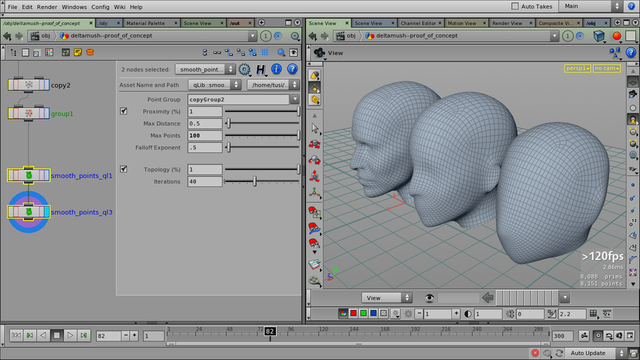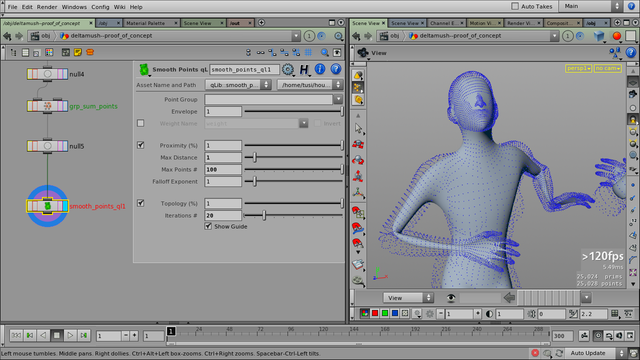interface version 1
A two-pass smoothing (“relax”) of polygon mesh points.
This operator provides relaxation of geometry points, using a combination of multiple methods (or passes).

Geometry smoothing -- left: original, center: proximity-based, right: topology-based smoothing.

Heavily smoothed animated geometry, with guide geometry indicating the original shape (in blue).
Methods
The following methods (passes) are available:
Point proximity-based
pros: fast / cons: inaccurate
Point positions are relaxed by averaging with spatially-close neighbours (without any consideration for topology). It is a point cloud-based approach, with the usual parameters.
This pass doesn’t require any geometry but points (so it works for particles, point clouds, etc.)
It is very fast, although a bit inaccurate, and better suited for static geometry (as opposed to one with animated deformations). Applying an additional topology-based pass is recommended.
Topology-based (Laplacian)
pros: accurate / cons: slow
This method smooths points by averaging the positions of topological neighbours. It requires an actual geometry topology (for point connectivity). It also needs to be run for multiple iterations (with run time increasing linearly).
Tip
Take advantage of the strengths of both algorithms and avoid their weaknesses – try using a carefully-tuned 1st pass, so the 2nd pass could be run with fewer iterations.
Parameters
| Point Group | The group of points to be smoothed. | ||||||||||||||
| Envelope, Weight Name | Standard deformer envelope and weighting-related parameters. | ||||||||||||||
| Proximity Based |
| ||||||||||||||
| Topology Based |
| ||||||||||||||
| (misc) |
|
To Do
Implement HC method (Humphrey's)
Should work on other attributes than
PAdd
N(normal) support to point cloud mode?
Release Notes
interface version 1 —
| 2014-09-04 |
|
| 2014-08-29 |
|
| 2014-08-17 |
|
| 2014-08-14 |
|
| 2014-08-13 |
|